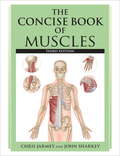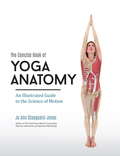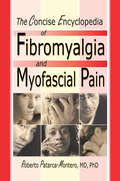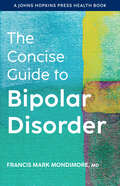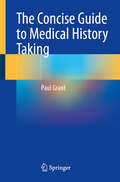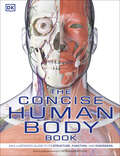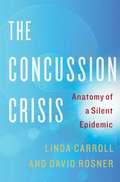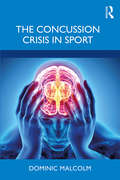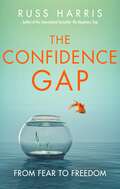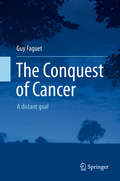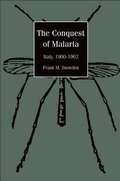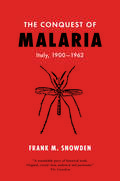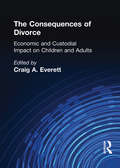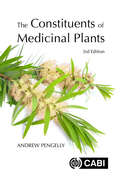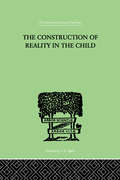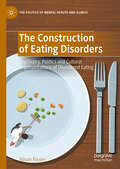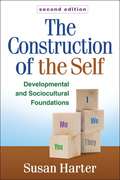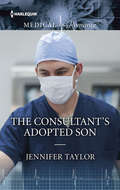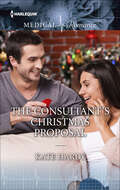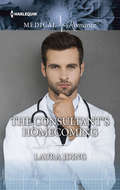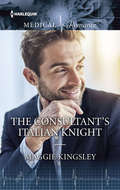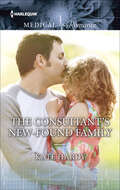- Table View
- List View
The Concise Book of Muscles, Third Edition
by Chris Jarmey John SharkeyUpdated with the latest human anatomy and biomechanics research, the third edition of this authoritative, best-selling book offers a comprehensive introduction to emerging explanations of new models of living motion and human architecture. Detailed, full-color anatomical drawings and clear, succinct text identify all the major muscles, showing the origin, insertion, action, and innervation of each muscle. Designed to make complex topics easily accessible to medical students and anyone interested in anatomy and movement, The Concise Book of Muscles is a quick, information-packed, and user-friendly guide to this rapidly-growing and important field.
The Concise Book of Yoga Anatomy
by Jo Ann Staugaard-JonesThe Concise Book of Yoga Anatomy is the definitive guide to the study of yoga anatomy--a perfect companion book for any yoga teacher or practitioner seeking to understand the biomechanics of the body as it applies to yoga practice. The book is visually designed in quick reference format to offer useful information about the main skeletal muscles that are central to yoga, with asanas to demonstrate the particular muscles and muscle groups. Over 230 full color illustrations detail each muscle's origin, insertion, and action in order to clearly reveal how the muscles come into play in the movements and postures of yoga. Knowledge of yoga anatomy is paramount to the ability to teach or practice with no injury to oneself or others. With this foundation in place, it is possible to focus on the spiritual element of yoga as well as the physical. Yoga is a union of the two, so where appropriate, the more profound side of the practice is mentioned as it relates to the body. The Concise Book of Yoga Anatomy illustrates the form and function of the muscles first, then interlays the muscles into the yoga posture for full understanding in a clear and integrated way, explaining the technique of the asanas, as well as other important aspects of yoga: pranayamas, the bandhas, and chakras. Table of Contents About This Book 1 Anatomical Orientation 2 Muscles of Respiration 3 Muscles of the Face and Neck 4 Muscles of the Spine 5 The Deep Core and Pelvic Floor 6 Muscles of the Shoulder and Upper Arm 7 Muscles of the Forearm and Hand 8 Muscles of the Hip 9 Muscles of the Knee 10 Muscles of the Ankle/Foot Resources General Index Index of MusclesFrom the Trade Paperback edition.
The Concise Encyclopedia of Fibromyalgia and Myofascial Pain
by Roberto Patarca MonteroAn A-to-Z look at these crippling disorders!Compiled by one of the foremost researchers in the field of immunology, The Concise Encyclopedia of Fibromyalgia and Myofascial Pain is an A-to-Z summary of current knowledge that updates patients and health care professionals on these disabling clinical disorders. This vital information has been organized in an easy-to-use format that lets you become familiar with highlights of the most relevant topics.The Concise Encyclopedia of Fibromyalgia and Myofascial Pain gives you immediate access to the latest advances in rheumatology, cardiovascular medicine, endocrinology, epidemiology, immunology, infectious diseases, neurology, psychiatry, and psychology that form the basis for new lines of research and therapeutic intervention. This comprehensive reference summarizes information published mainly in the last decade, providing a thoughtful and balanced resource that will educate and increase awareness of these often-misdiagnosed disorders.The Concise Encyclopedia of Fibromyalgia and Myofascial Pain allows easy access to: relevant case study findings, summarized to provide the answers you need evidence-based alternative medicine approaches pertinent findings on related disorders an extensive bibliography Comprehensive and thorough, The Concise Encyclopedia of Fibromyalgia and Myofascial Pain gives you the information you’ve been looking for on these painful disorders that affect more than six million Americans. This important book gives health care professionals a greater understanding and awareness of fibromyalgia and myofascial pain and gives patients help at their fingertips.
The Concise Guide to Bipolar Disorder (A Johns Hopkins Press Health Book)
by Francis Mark MondimoreA concise, essential guide to living with bipolar disorder by an internationally known expert.When a diagnosis of bipolar disorder enters your life, you may not be sure where to turn for accurate information about this potentially devastating but treatable illness. Whether you yourself have been diagnosed, or a spouse, parent, child, friend, or employee has developed the illness, the need for information and advice is acute. Presenting the essentials of diagnosis and treatment clearly and succinctly, leading psychiatrist Dr. Francis Mark Mondimore distills everything you need to know about bipolar disorder in this new indispensable guide. In down-to-earth language, Dr. Mondimore explains what bipolar disorder is and how you (or your loved one) can live your best life with the help of medications, therapy, the support of family and friends, and medical care. An extensive list of references is included, along with additional suggested reading materials and online resources. Realistic clinical descriptions and anecdotes reflecting on fascinating historical details associated with this condition provide further information. The Concise Guide to Bipolar Disorder is an excellent up-to-date resource for the newly diagnosed or those seeking rapid answers to the most common questions about bipolar disorder.Past Praise for Books by Francis Mark Mondimore, MD"Offers advice on how to live with bipolar disorder, and how not to become its victim."—Large Print Reviews"An enlightened, pragmatic, and empathic resource for this very complex and challenging illness."—Journal of Clinical Psychiatry"An absolute gold mine for those with the disorder and their families: thorough, candid, and up-to-date advice, full of new possibilities for help."—Kirkus Reviews
The Concise Guide to Medical History Taking
by Paul GrantThis concise medical reference is designed to help medical students, doctors, nurses and physician's associates apply best practice to the taking of effective medical histories. It provides informative but succinct guidance for clinical professionals on how to capture and interpret a medical history from their patients. The approach presented is new and innovative, and based on expert medical opinion and in depth research with senior clinical leads from multiple medical and surgical specialities from the UK's leading virtual hospital. The Concise Guide to Medical History Taking makes use of the development of new patient-focussed medical history tools, where the essential elements of clinical history taking have been refined and improved in order to develop a meaningful and relevant way of taking a clinical history whilst avoiding much of the traditional filler content that is taught traditionally. The question sets are now more user friendly, discriminating and linked to the underlying set of differential diagnoses. This reflects an updated approach to clinical history taking, seeking tangible benefits, based on the evidence of what has been found to be most useful in real world clinical practice. With a foreword by Dr Richard Chudleigh, Consultant Physician & Diabetologist, Singleton Hospital, Associate Professor, Swansea University Medical School
The Concise Human Body Book (DK Human Body Guides)
by DKDiscover all there is to know about human anatomy in DK's latest concise visual guide to the human body.Fully updated to reflect the latest medical information, The Concise Human Body Book is illustrated throughout with colorful and comprehensive diagrams, photographs, scans, and 3D artworks, which take you right into the cells and fibers that are responsible for keeping your body ticking.The Concise Human Body Book provides full coverage of the body, function by function, system by system. In the opening chapter, colorful medical scans, illustrations, and easy-to-understand diagrams show you how the different parts of the body work together to produce a living whole. Eleven main body systems - including the skeletal system, cardiovascular system, and respiratory system - are then covered in intricate detail in the following chapters, with each section ending on common diseases and disorders that can affect that system.From bones and muscles to systems and processes, this in-depth, pocket-sized guide to the body's physical structure, chemical workings, and potential problems is the must-have reference manual for trainee medical professionals, students, or anyone interested in finding out more about how the human body works.
The Concise Manual of Apheresis Therapy
by Eisei Noiri Norio HanafusaThis pocket-sized manual serves as a concise and ideal reference work for therapeutic approaches using apheresis, Covering both basic theory and clinical details to facilitate improved treatment and patient outcomes, the text considers a variety of diseases, including myasthenia gravis, multiple sclerosis, Guillain-Barre syndrome, chronic inflammatory demyelinating polyneuropathy, nephrotic syndrome, TTP/TMA, dilated cardiomyopathy, and many other conditions. The books also reviews the growing trend towards adopting this unique therapy for a wide range of health management issues such as morbid obesity and/or type 2 diabetes, and for lowering LDL-cholesterol (cholesterol apheresis) in patients unresponsive to medication or lifestyle modification.
The Concussion Crisis
by David Rosner Linda CarrollFOR FAR TOO LONG, the menace of concussions has been hidden in plain sight. On playing fields across America, lives are being derailed by seemingly innocuous jolts to the head. From the peewees to the pros, concussions are reaching epidemic proportions. This book brings that hidden epidemic and its consequences out of the shadows. As frightening as the numbers are--estimates of sports-related concussions range from 1.6 million to 3.8 million annually in the United States--they can't begin to explain the profound impact of a hidden health problem that can strike any of us. It is becoming increasingly clear that concussions, like severe head traumas, can rob us of our memory, our mental abilities, our very sense of self. Because the damage caused by a concussion is rarely visible to the naked eye or even on a brain scan, no one knows how many millions might be living lives devastated by an invisible injury too often shrugged off as "just a bump on the head." This book puts a human face on a huge public health crisis. Through narratives that chronicle the poignant experiences of real people struggling with this invisible and often unrecognized brain injury, Linda Carroll and David Rosner bring home its potentially devastating consequences. Among those you will meet are a high school football player whose college dreams were derailed by a series of undiagnosed concussions, a hard-driving soccer star whose own struggles with concussions pushed her to crusade for safety reform as a coach and soccer mom, and an economist who lost her career because of lingering concussion symptoms from a fender bender. The Concussion Crisis weaves these human dramas with compelling stories of scientists and doctors who are unraveling the mysteries of how an invisible injury can wreak such havoc. It takes readers into the top labs, where scientists are teasing out what goes wrong in the brain after a jolt to the head, and into the nation's leading concussion clinic, where patients get cutting-edge management and treatment. Carroll and Rosner analyze the cultural factors that allowed this burgeoning epidemic to fester unseen and untreated. They chronicle the growing public awareness sparked by the premature retirements of superstars like NFL quarterbacks Troy Aikman and Steve Young. And they argue for an immediate change in a macho culture that minimizes the dangers inherent in repeated jolts to the head. The Concussion Crisis sounds an urgent wake-up call to parents, coaches, trainers, doctors, and the athletes themselves. The book will stand as the definitive exploration of this heretofore-silent health crisis. It should be required reading for every parent with a child playing sports--in fact, by everyone who has ever suffered a hard bump on the head.
The Concussion Crisis in Sport
by Dominic MalcolmConcussion has become one of the most significant issues in contemporary sport. The life-changing impact of head injury and the possible threat that chronic traumatic encephalopathy poses to children and young athletes in particular is calling into question the long-term future of some of our most well-established sports. But what are the real issues behind the headlines and the public outcry, and what can and should be done to save sport from itself? This concise, provocative introduction draws on perspectives from sociology, medicine, ethics, psychology, and public health to answer these questions and more. The book explores the context in which the current cultural crisis has emerged. It assesses the current state of biomedical knowledge; the ethics of regulating for brain injury; the contribution of the social sciences to understanding the behaviour of sports participants; and the impact of public health interventions and campaigns. Drawing on the latest research evidence, the book explores the social roots of sport’s concussion crisis and assesses potential future solutions that might resolve this crisis. This is essential reading for anybody with an interest in sport, from students and researchers to athletes, coaches, teachers, parents, policy-makers, and clinicians.
The Confidence Gap: From Fear to Freedom
by Russ HarrisA hands-on self-help guide to gaining long-lasting confidence and overcoming fear using mindfulness-based therapy and acceptance and commitment therapy (ACT).Bestselling author Russ Harris explains how many of us are playing the 'confidence game' using the wrong rules, and guides you hrough clear, simple exercises designed to help you manage difficult emotions such as anxiety, and to build genuine confidence. The Confidence Gap is instructive, reassuring and gentle in tone, and provides proven ways to build your self-esteem and take you from fear to freedom.
The Connected Self
by Heather WiddowsCurrently, the ethics infrastructure - from medical and scientific training to the scrutiny of ethics committees - focuses on trying to reform informed consent to do a job which it is simply not capable of doing. Consent, or choice, is not an effective ethical tool in public ethics and is particularly problematic in the governance of genetics. Heather Widdows suggests using alternative and additional ethical tools and argues that if individuals are to flourish it is necessary to recognise and respect communal and public goods as well as individual goods. To do this she suggests a two-step process - the 'ethical toolbox'. First the harms and goods of the particular situation are assessed and then appropriate practices are put in place to protect goods and prevent harms. This debate speaks to core concerns of contemporary public ethics and suggests a means to identify and prioritise public and common goods.
The Conquest of Cancer
by Guy FaguetBased on 30 years of clinical and research experience, backed by a careful assessment of four decades of published data, Dr. Faguet documented in The War on Cancer (Springer 2005), early advances in cancer treatment and patient survival that soon stalled. Ten years later and after an exhaustive analysis of evidence-based data available through 2013 that incorporates 755 references, he reveals the root causes of the stagnation in cancer control, including the role played by major stakeholders and advocates a coordinated national effort, akin to the Apollo program, to unveil the causes of cancer and their mastery. In the interim, Dr. Faguet urges caregivers to manage patients according to the four ethical principles of beneficence, non-maleficence, respect for patients' autonomy and justice especially at the end of life.
The Conquest of Malaria: Italy, 1900-1962
by Frank M. SnowdenAt the outset of the twentieth century, malaria was Italy's major public health problem. It was the cause of low productivity, poverty, and economic backwardness, while it also stunted literacy, limited political participation, and undermined the army. In this book Frank Snowden recounts how Italy became the world center for the development of malariology as a medical discipline and launched the first national campaign to eradicate the disease. Snowden traces the early advances, the setbacks of world wars and Fascist dictatorship, and the final victory against malaria after World War II. He shows how the medical and teaching professions helped educate people in their own self-defense and in the process expanded trade unionism, women's consciousness, and civil liberties. He also discusses the antimalarial effort under Mussolini's regime and reveals the shocking details of the German army's intentional release of malaria among Italian civilians--the first and only known example of bioterror in twentieth-century Europe. Comprehensive and enlightening, this history offers important lessons for today's global malaria emergency.
The Conquest of Malaria: Italy, 1900-1962
by Frank M. SnowdenAt the outset of the twentieth century, malaria was Italy’s major public health problem. It was the cause of low productivity, poverty, and economic backwardness, while it also stunted literacy, limited political participation, and undermined the army. In this book Frank Snowden recounts how Italy became the world center for the development of malariology as a medical discipline and launched the first national campaign to eradicate the disease. Snowden traces the early advances, the setbacks of world wars and Fascist dictatorship, and the final victory against malaria after World War II. He shows how the medical and teaching professions helped educate people in their own self-defense and in the process expanded trade unionism, women’s consciousness, and civil liberties. He also discusses the antimalarial effort under Mussolini’s regime and reveals the shocking details of the German army’s intentional release of malaria among Italian civilians—the first and only known example of bioterror in twentieth-century Europe. Comprehensive and enlightening, this history offers important lessons for today’s global malaria emergency.
The Conquest of Viruses: A History of Viral Vaccines
by Van G. WilsonThis book guides through the fascinating history of viral vaccines, from the first primitive smallpox vaccination in the 18th century to the cutting-edge RSV formulation approved in 2023. Each chapter delves into the scientific, clinical, and social forces that led to the development of these life-saving medical innovations, highlighting the scientists who played pivotal roles. With a focus on making complex science accessible and history engaging, this book offers a comprehensive portrayal of virology, vaccinology and the interplay between science and society in shaping public health. Readers will explore key concepts such as the evolution of vaccine technology over time, from cowpox material to mRNA vaccines, and a wide array of other topics, including the eradication of diseases through vaccines, the challenges of immunization against influenza, and the revolutionary impact of COVID-19 vaccination. The author, microbiologist Professor Wilson, provides expert analysis on how sociological factors influenced vaccine progress and gets to the bottom of the question of why there is still no vaccine for some critical diseases. This book is a must-read for anyone with an interest in viruses and vaccines. Whether you're a researcher or simply fascinated by medical history, this book promises to be both informative and entertaining.
The Consequences of Divorce: Economic and Custodial Impact on Children and Adults
by Craig A. EverettThis comprehensive volume brings to light little known implications of legal, economic, and custodial factors following a divorce. The Consequences of Divorce goes beyond the past decade’s extensive focus on emotional and social adjustment outcomes to explore in-depth the post-divorce legal, economic, and custodial variables that impact the entire family. This important volume examines the economic conditions of both marriage partners after the divorce, the effect of legislative models on child support payment, child custody patterns and their impact on the family, and intervention strategies that take such custody problems into account. Teachers, counselors, researchers, and attorneys will be better prepared to offer support to family members after a divorce with the understanding of the economic and custodial conflicts that they will gain from this new book.The authoritative contributors examine statistics that show a marked decline in the economic well-being of women and children, which lead to questions of standards of adequacy for child support awards and an exploration of a new child support scheme from Australia. Different child custody arrangements are analyzed according to their consequences for each family member, providing valuable information for treating divorced families. Specific topics of interest include decreased parental involvement for fathers after a divorce, siblings separated by divorce, mothers without custody, and children’s own viewpoints of custody arrangements. This informative book will lead to increased services to divorced families by expanding professionals’awareness of critical economic and legal issues that affect each member of the family.
The Constituents of Medicinal Plants: An Introduction To The Chemistry And Therapeutics Of Herbal Medicine
by Dr Andrew PengellyA classic in the literature of herbal medicine, this book explains in simple terms the commonly occurring chemical constituents of medicinal plants, and how these react with the human body. The major classes of plant constituents, such as phenols, terpenes and polysaccharides, are described both in terms of their chemical structures and their pharmacological activities. The last 20 years has seen huge growth in research output in phytochemistry, and this edition has been thoroughly revised to incorporate up-to-date research. It contains a new chapter on resins and cannabinoids, and additional content on macrocarpals, essential oil chemotypes, mushroom polysaccharides, phytochemical synergy, and toxicology of phytochemicals. Features include: · Over 200 diagrams of chemical structures · Coverage of energetics, synergism and the emerging field of network pharmacology · New content on seaweeds and fungi, and polyphenol-rich foods · References to primary research literature in pharmacy, pharmacology, chemistry, plant biology, molecular biology, integrative medicine and many other disciplines Written by an experienced herbal practitioner, The Constituents of Medicinal Plants has become a standard textbook for courses on plant-based medicine. It is also an essential desktop reference for health practitioners, lecturers, researchers, producers, and anyone with an interest in how medicinal herbs work.
The Construction Of Reality In The Child (International Library Of Psychology Ser.)
by Piaget, JeanFirst published in 1999. Routledge is an imprint of Taylor & Francis, an informa company.
The Construction of Eating Disorders: Psychiatry, Politics and Cultural Representations of Disordered Eating (The Politics of Mental Health and Illness)
by Alison FixsenThis book draws on original research to critically examine the social and industrial construction of eating disorders and disordered eating, in an analysis that encompasses psychiatry and health, cultural representations, and the politics of eating disorders. Centrally, it examines the extent to which eating disorders are not ‘made’ by individuals, but rather constructed by groups who claim investment, experience, and expertise in the diagnosis, labeling, treatment, and management of disordered eating. It demonstrates the impacts of biomedical, psychiatric, legal, pharmaceutical, technical and consumer groups, as well as that of the fast-food, fashion, media and social media industries. In doing so, it reveals how they shape the ways that eating disorders are perceived, spoken of, written about, and managed within institutions and wider society. It will appeal to students and scholars of mental health, critical psychology, medical sociology and anthropology and gender studies, and others interested in our future health.
The Construction of the Self, Second Edition
by Susan Harter William M. BukowskiAn important work from a leading scholar, this book explores self-development from early childhood to adulthood. Susan Harter traces the normative stages that define the emergence of many self-processes, including self-esteem. She also addresses individual differences and societal influences on self-development. Presenting pioneering empirical research, Harter shows that increasingly mature features of the self have both benefits and liabilities for psychological adjustment. The book highlights the causes and consequences of different types of self-representations, including those that are unrealistically negative or positive. New to This Edition *Reflects more than a decade of conceptual, empirical, and methodological advances. *Provides a broader sociocultural framework for understanding self-development. *Chapters on emerging adulthood, self-esteem and physical appearance, self-processes in the classroom, motivation, cross-cultural issues, and the quest for authenticity. *Expanded chapters on childhood, adolescence, and the self-conscious emotions. *Increased attention to the liabilities of our contemporary preoccupation with the self.
The Consultant's Adopted Son
by Jennifer TaylorThe mother of his child Beautiful nurse Rose Tremayne would have done anything to have kept her baby. Circumstances forced her into adoption, though there hasn't been a day when she hasn't found herself wondering what happened to her precious little boy. Then Rose finds herself working with consultant Owen Gallagher--her son's adopted father. Owen is worried about the effect she will have on his son's life... and his own! Yet he knows he can not deny the intensity of emotion he feels for her.
The Consultant's Christmas Proposal
by Kate HardyConsultant Toby Barker has a secret…He has been in love with his best friend Dr. Saskia Haywood for years.Dr. Saskia Haywood also has a secret…She's struggling to come to terms with an illness that could ruin not only her ability to work in the maternity ward, but also her chances of having children.Now both secrets are out…Saskia knows of Toby's desire for a family—something she'll never be able to give him—but what she doesn't realize is that Toby will do anything for her. Starting with a Christmas proposal she'll never forget!
The Consultant's Homecoming
by Laura IdingNurse Abby Monroe is intrigued by the aloof, handsome consultant Nick Tremayne. When they work together at the physical-rehabilitation unit, she begins to see the dedicated, caring physician behind his reserve. Abby realizes she is in real danger of losing her heart to this man. But Nick bears the scars of his past, and has been keeping a secret for months. As his feelings for Abby grow, he is forced to confront the truth, knowing he must tell her the real reason why he returned. But that means possibly losing the one woman he has ever truly loved.
The Consultant's Italian Knight
by Maggie KingsleyHer protector in the E.R. Consultant Kate Kennedy arrives at work surprised to discover that her patient is being investigated by dark, gorgeous police inspector Mario Volante. Mario's Italian charm and bright blue eyes pierce right through Kate to the vulnerable woman underneath. But Kate is newly divorced, and Mario has very good reasons for not letting their relationship get personal. Yet when Kate's life is endangered Mario insists that he stay with her. Suddenly his overnight vigil provides too great a temptation, and Kate finds herself in his strong and protective arms.
The Consultant's New-Found Family (Bachelor Dads Ser. #9)
by Kate HardyA mother for his daughterEver since Joel Mortimer lost his wife, he's thrown himself into his work and been a dedicated single father to his daughter, Beth. Joel wrongly blames himself for the loss of Beth's mother and their unborn child. He has vowed never to have another child, or put his little girl through any more trauma—until he meets his new colleague, Lisa Richardson.Though Lisa isn't looking for commitment either, she can't resist Joel, and one night they give in to temptation. But when Lisa finds out she's pregnant, they both have some soul-searching to do.
